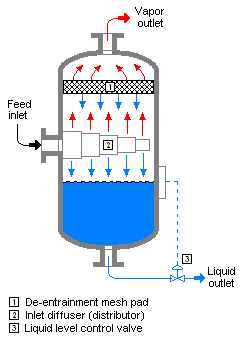Vapor–liquid separator

A vapor–liquid separator is a device used in several industrial applications to separate a vapor–liquid mixture.
A vapor–liquid separator may also be referred to as a Flash Drum, Breakpot, Knock-out drum, Knock-out pot, Compressor suction drum or Compressor Inlet Drum. When used to remove suspended water droplets from streams of air, it is often called a demister.
Method of operation
For the common variety, gravity is utilized in a vertical vessel to cause the liquid to settle to the bottom of the vessel, where it is withdrawn.[1][2][3][4]
In low gravity environments such as a space station, a common liquid separator will not function because gravity is not usable as a separation mechanism. In this case, centrifugal force needs to be utilised in a spinning centrifugal separator to drive liquid towards the outer edge of the chamber for removal. Gaseous components migrate towards the center.
For both varieties of separator, the gas outlet may itself be surrounded by a spinning mesh screen or grating, so that any liquid that does approach the outlet strikes the grating, is accelerated, and thrown away from the outlet.
The vapor travels through the gas outlet at a design velocity which minimises the entrainment of any liquid droplets in the vapor as it exits the vessel.
The feed to a vapor–liquid separator may also be a liquid that is being partially or totally flashed into a vapor and liquid as it enters the separator.
Liquid level monitoring
The separator is only effective as long as there is an air space inside the chamber. The separator can fail if either the mixed inlet is overwhelmed with supply material, or the liquid drain is unable to handle the volume of liquid being collected. The separator may therefore be combined with some other liquid level sensing mechanism such as a sight glass or float sensor. In this manner, both the supply and drain flow can be regulated to prevent the separator from becoming overloaded. (Agastya, Bayu)
Where vapor–liquid separators are used
Vapor–liquid separators are very widely used in a great many industries and applications, such as:
- Oil refineries
- Natural-gas processing plants (NGL)
- Petrochemical and chemical plants
- Refrigeration systems
- Air conditioning
- Compressor systems
- Gas pipelines
- Steam condensate flash drums
- Geothermal power plants
- Combined cycle power plants
- Flare stacks
- Soil vapor extraction
- Paper mills
Preventing pump damage
In refrigeration systems, it is common for the system to contain a mixture of liquid and gas, but for the mechanical gas compressor to be intolerant of liquid.
Some compressor types such as the scroll compressor use a continuously shrinking compression volume. Once liquid completely fills this volume the pump may either stall and overload, or the pump chamber may be warped or otherwise damaged by the fluid that can not fit into a smaller space.
See also
- Flash evaporation
- Vapor-compression refrigeration
- Souders–Brown equation (for sizing vapor–liquid separators)
- Steam drum
References
- ↑ William D. Baasel (1990). Preliminary Chemical engineering Plant Design (2nd ed.). Van Nostrand Reinhold. ISBN 0-442-23440-6. OCLC 18907139.
- ↑ David H.F. Liu (1997). Environmental Engineers' Handbook (2nd ed.). CRC Press. ISBN 0-8493-9971-8. OCLC 35886123.
- ↑ Stanley S. Grossel (June 2004). "Design and sizing of knock-out drums/catchtanks for emergency relief systems". Plant/Operations Progress (AIChE). 5 (3): 129–135. ISSN 0278-4513. doi:10.1002/prsb.720050304.
- ↑ Stanley M. Walas (1988). Chemical Process Equipment:Selection and Design. Butterworth-Heinemann. ISBN 0-409-90131-8. OCLC 16714037.
External links
- Experimental Characterization of High-Pressure Natural Gas Scrubbers by Trond Austrheim (preprints of papers based on PhD Thesis at the University of Bergen, Norway, 2006)
- Flash Steam Tutorial The benefits of recovering flash steam, how it is done and typical applications.
- Quick Calculator for Horizontal Knock Out Drum sizing Based on minimum time required for liquid droplets of a given minimum size to be separated.
- Design Criteria for Vapor/Liquid Separators
- Detailed explanation of high performance vapor-liquid separators (scrubbers)
- Vapor Liquid Separator designs and manufacturing process